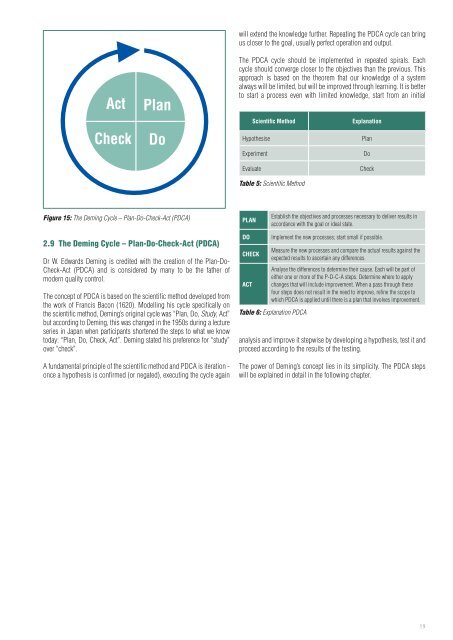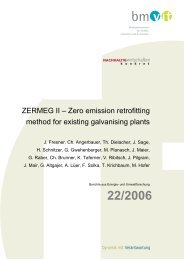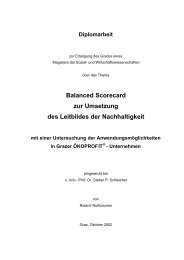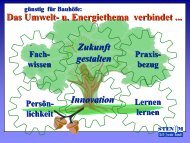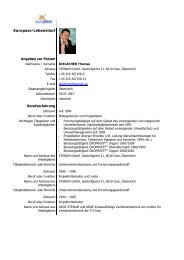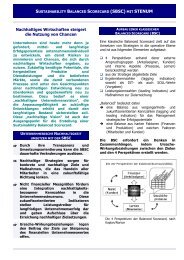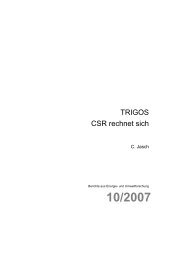Promoting Resource Efficiency in Small & Medium size ... - UNEP
Promoting Resource Efficiency in Small & Medium size ... - UNEP
Promoting Resource Efficiency in Small & Medium size ... - UNEP
You also want an ePaper? Increase the reach of your titles
YUMPU automatically turns print PDFs into web optimized ePapers that Google loves.
Act<br />
Check<br />
Plan<br />
Do<br />
will extend the knowledge further. Repeat<strong>in</strong>g the PDCA cycle can br<strong>in</strong>g<br />
us closer to the goal, usually perfect operation and output.<br />
The PDCA cycle should be implemented <strong>in</strong> repeated spirals. Each<br />
cycle should converge closer to the objectives than the previous. This<br />
approach is based on the theorem that our knowledge of a system<br />
always will be limited, but will be improved through learn<strong>in</strong>g. It is better<br />
to start a process even with limited knowledge, start from an <strong>in</strong>itial<br />
Scientific Method<br />
Hypothesise<br />
Experiment<br />
Explanation<br />
Plan<br />
Do<br />
Evaluate<br />
Check<br />
Table 5: Scientific Method<br />
Figure 15: The Dem<strong>in</strong>g Cycle – Plan-Do-Check-Act (PDCA)<br />
PLAN<br />
Establish the objectives and processes necessary to deliver results <strong>in</strong><br />
accordance with the goal or ideal state.<br />
2.9 The Dem<strong>in</strong>g Cycle – Plan-Do-Check-Act (PDCA)<br />
Dr W. Edwards Dem<strong>in</strong>g is credited with the creation of the Plan-Do-<br />
Check-Act (PDCA) and is considered by many to be the father of<br />
modern quality control.<br />
The concept of PDCA is based on the scientific method developed from<br />
the work of Francis Bacon (1620). Modell<strong>in</strong>g his cycle specifically on<br />
the scientific method, Dem<strong>in</strong>g’s orig<strong>in</strong>al cycle was “Plan, Do, Study, Act”<br />
but accord<strong>in</strong>g to Dem<strong>in</strong>g, this was changed <strong>in</strong> the 1950s dur<strong>in</strong>g a lecture<br />
series <strong>in</strong> Japan when participants shortened the steps to what we know<br />
today: “Plan, Do, Check, Act”. Dem<strong>in</strong>g stated his preference for “study”<br />
over “check”.<br />
A fundamental pr<strong>in</strong>ciple of the scientific method and PDCA is iteration -<br />
once a hypothesis is confirmed (or negated), execut<strong>in</strong>g the cycle aga<strong>in</strong><br />
DO<br />
CHECK<br />
ACT<br />
Implement the new processes; start small if possible.<br />
Measure the new processes and compare the actual results aga<strong>in</strong>st the<br />
expected results to ascerta<strong>in</strong> any differences.<br />
Analyse the differences to determ<strong>in</strong>e their cause. Each will be part of<br />
either one or more of the P-D-C-A steps. Determ<strong>in</strong>e where to apply<br />
changes that will <strong>in</strong>clude improvement. When a pass through these<br />
four steps does not result <strong>in</strong> the need to improve, ref<strong>in</strong>e the scope to<br />
which PDCA is applied until there is a plan that <strong>in</strong>volves improvement.<br />
Table 6: Explanation PDCA<br />
analysis and improve it stepwise by develop<strong>in</strong>g a hypothesis, test it and<br />
proceed accord<strong>in</strong>g to the results of the test<strong>in</strong>g.<br />
The power of Dem<strong>in</strong>g’s concept lies <strong>in</strong> its simplicity. The PDCA steps<br />
will be expla<strong>in</strong>ed <strong>in</strong> detail <strong>in</strong> the follow<strong>in</strong>g chapter.<br />
19


